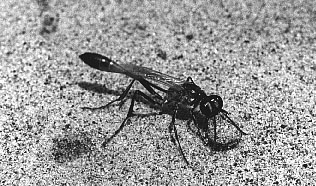
The Sphecid Wasps of Michigan
(Hymenoptera: Sphecidae: Sphecinae)

These web pages are derived from my 1989 paper, "Distribution and biology of the Sphecine wasps of Michigan (Hymenoptera: Sphecidae: Sphecinae)," which appeared in The Great Lakes Entomol. 22:199-217. I have updated the information that appeared in that paper and added the Ampulicinae to the list, too. I hope this resource will prove useful to people. If you do find it informative and useful, please send e-mail to [email protected].
Originally, I had transferred the distribution maps and
information about the sphecines of Michigan to a HyperCard stack.
Although I had it mostly completed some time ago, it languished in
the "unfinished projects" bin as I went on to other areas of
interest. What I hope to do with this web resource is to take
previously published information - updated with new information --
some published and some not, and make it more widely available to a
broader audience. There is a lot of "data" available on the web, but
little real "information." My goal is to make this an educational
and scientific resource.
The thread-waisted wasps, or Sphecinae (sensu Bohart and
Menke 1976) are conspicuous inhabitants of sandy areas, vacant lots,
and human residences (mud daubers). They have long been a favorite
group for ethologists and naturalists because of their large size and
easily observed nesting habits. Early authors such as Peckham and
Peckham (1898) Fabre (1915), Rau and Rau (1918), and Reinhard (1929)
gave much attention to various sphecines such as Sphex, Chlorion,
and Ammophila in their accounts of wasp behavior. Although
much has been printed about the sphecines in technical and popular
works many species have been only sparingly studied, and others not
at all. Much of the North American sphecid fauna is still poorly
studied ethologically (Krombein 1979).
The sphecines are behaviorally diverse, and a general outline of
their nesting habits is presented in Table 1. No attempt has been made to list all the
references that pertain to each species in the text, as Krombein
(1979) provides citations up to 1976. Only pertinent references are
given in the species accounts that follow.
Most sphecine genera are fossorial, but Podium, Chalybion,
Sceliphron, and Isodontia nest aerially, either in
preformed cavities (as do the Ampulicines) or in mud nests. Prey
selection is diverse, ranging from spiders to various groups of
Orthoptera and lepidopterous larvae. Wasp genera usually specialize
on a given order or family, with the various species differing in
prey selection at the family or genus level, stage of prey, size of
prey, or site of prey capture (arboreal versus fossorial
caterpillars). Evans and Eberhard (1970) provide an excellent review
of all types of sphecid behavior, and Bohart and Menke (1976)
provided behavioral synopses for each genus on a world-wide
basis.
Owing to the effects of glaciation, Michigan abounds in sandy areas.
As a consequence, there exists a wide range of habitable areas for
sand wasps. Dreisbach (1944) provided the first key and annotated
list of the thread-waisted wasps of the state. Due to later taxonomic
revisions and extensive collecting, his paper has been long outdated.
Michigan has representatives of all the l l genera of North American
Sphecinae, and 26 of the 127 North American species. Some of these
species reach their easternmost or northernmost distribution in the
state. Other species that are transcontinental are similarly
widespread in Michigan. These distributions are discussed under the
species accounts.
The sphecines are a taxonomically well-studied group in North
America. For identification of North American taxa other than the
Ammophilini, Bohart and Menke's reclassification of the subfamily
(1963) is recommended. On a world-wide level, Bohart and Menke's 1976
generic revision of the family Sphecidae is the definitive work. For
the Ammophilini, Murray ( 1940) is the best taxonomic reference for
Podalonia, and Menke (1964) for Eremnophila. Keys to Ammophila
published prior to 1964 are either incomplete or unreliable. Only
Menke's (1965) revision of North American Ammophila is
recommended for identification, but it is only available on microfilm
or microfilm based reprint from University Microfilms, Ann Arbor, MI.
Additional information on biology and taxonomy was given by Krombein
(1979).
The following annotated list of the Michigan sphecines is based upon
the examination of over 2800 specimens from various collections (see
Acknowledgments), and from personal observations in the feld. Voucher
specimens for those species upon which behavioral data are based are
deposited at The University of Michigan Museum of Zoology. Flower
records are based upon personal observations or label data and do not
include previously published records. Localities given as Livingston
County are from the Edwin S. George Reserve (ESGR). Abbreviations for
sections of the state of Michigan are LP for Lower Peninsula, UP for
Upper Peninsula, SLP and NLP for the southern and northern regions of
the LP. The number of specimens examined is given as an indicator of
relative abundance for the various species, and to indicate the
sample size.
Dolichurus greenei Rohwer
Ampulex canaliculata Say
Chlorion aerarium Patton
Podium luctuosum Smith
Podium rufipes Fabr.
Chalybion californicum (Saussure)
Sceliphron caementarium (Drury)
Sphex ichneumoneus (Linn.)
Sphex pensylvanicus Linn.
Isodontia auripes (Fernald)
Isodontia mexicana (Saussure)
Palmodes dimidiatus (DeGeer)
Prionyx atratus (Lepeletier)
Podalonia luctuosa (Smith)
Podalonia robusta (Cresson)
Podalonia sericea Murray
Podalonia violaceipennis
(Lepeletier)
Eremnophila aureonotata
(Cameron)
Ammophila azteca Cameron
Ammophila cleopatra Menke
Ammophila evansi Menke
Ammophila harti (Fernald)
Ammophila kennedyi (Murray)
Ammophila leoparda (Fernald)
Ammophila mediata Cresson
Ammophila nigricans (Dahlbom)
Ammophila pictipennis (Walsh)
Ammophila procera Dahlbom
Ammophila
urnaria Dahlbom
Sphecid Wasp Videos - From Brown Bag Productions - Dick Walton has some video clips of several species of sand wasps, including Eremnophila aureonotata and Sphex pensylvanicus. Excellent video of nesting behavior! (08/31/2006)
Added color photos of pinned adult females on most of the pages. The specimens were placed on their side on a UMAX S-6E color scanner and scanned into Adobe Photoshop at 300 dpi at 200 percent resolution. They were edited and saved to 72 dpi and resized for the web. (01/21/1998)